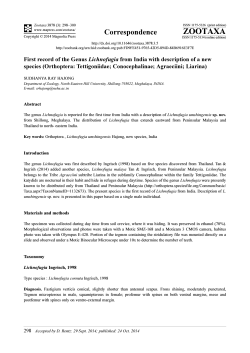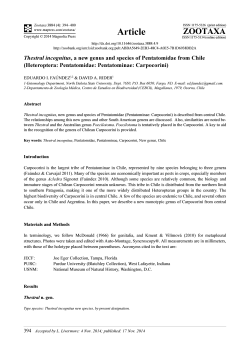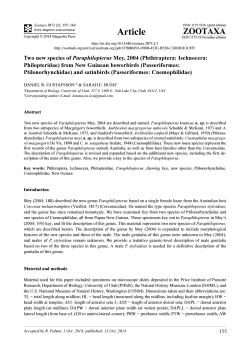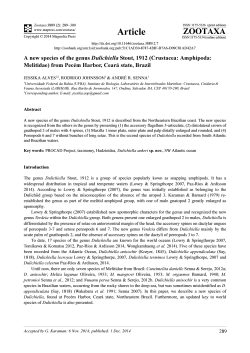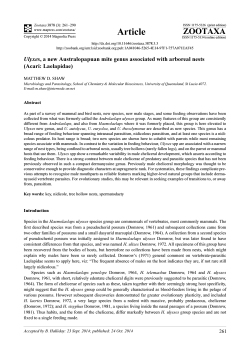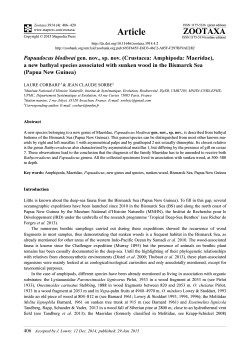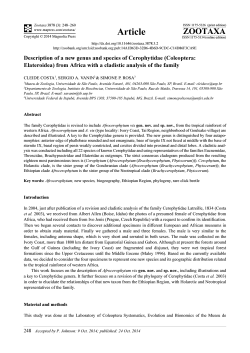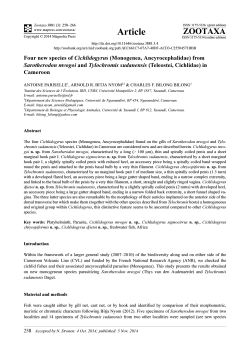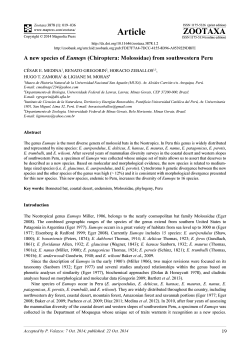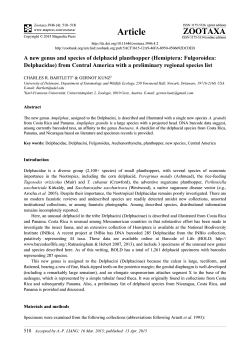
Article ZOOTAXA
Zootaxa 3881 (4): 328–340 www.mapress.com /zootaxa / Copyright © 2014 Magnolia Press Article ISSN 1175-5326 (print edition) ZOOTAXA ISSN 1175-5334 (online edition) http://dx.doi.org/10.11646/zootaxa.3881.4.2 http://zoobank.org/urn:lsid:zoobank.org:pub:B7057DBC-B1D0-4864-83E9-4A6C2852F068 A new species of the cardinalfish genus Siphamia (Perciformes, Apogonidae) from West Papua, Indonesia OFER GON1,5, GERALD R. ALLEN2, MARK V. ERDMANN3, 4 & GAVIN GOUWS1 1 South African Institute for Aquatic Biodiversity, Private Bag 1015, Grahamstown 6140, South Africa. E-mails: o.gon@saiab.ac.za and g.gouws@saiab.ac.za 2 Department of Aquatic Zoology, Western Australian Museum, Locked Bag 49, Welshpool DC, Perth, Western Australia 6986. E-mail: gerry.tropicalreef@gmail.com 3 Conservation International Indonesia Marine Program, Jl. Dr. Muwardi No. 17, Bali, Indonesia 80361. E-mail: mverdmann@gmail.com 4 California Academy of Sciences, 55 Music Concourse Drive, Golden Gate Park, San Francisco CA 94118 USA 5 Corrsesponding author Abstract A new species of the cardinalfish genus Siphamia is described from specimens collected in the Province of West Papua, Indonesia, at depths of 50–72 m. Siphamia papuensis n. sp. has a striated light organ which makes it a member of the S. tubifer species group. Within this group it is closely related to S. argentea, sharing with the latter 13 pectoral-fin rays, 9 developed gill rakers and an irregular pattern of yellowish green bars on the body. It differs from S. argentea in having an incomplete lateral line and in lacking dark marks on the head, and at the origin and end of the dorsal-fin and anal-fin bases, as well as the absence of red spots along the light organ and along the back. Japanese records of S. tubulata are reidentified as S. argentea, and new locality records for S. argentea and S. stenotes are reported. Analysis of sequence data from a 16S rDNA fragment revealed the clear separation of S. papuensis n. sp., S. argentea and other included Siphamia species (S. jebbi, S. tubifer and S. stenotes). Key words: Bali, Milne Bay, Siphamia argentea, Siphamia papuensis n. sp., Siphamia tubulata, Siphamia stenotes, Siphamia jebbi, taxonomy, Vanuatu Introduction The Indo-Pacific apogonid genus Siphamia is unique among the family in having a bacterial bioluminescent system and spinoid scales. The group contains 23 species and was recently reviewed by Gon and Allen (2012). This genus has two main species groups: the Siphamia tubifer group has dark vertical or slanted striations on the light organ whereas the Siphamia tubulata group has dark dots scattered along the light organ. Species of Siphamia occur mainly on coral reefs and are frequently associated with invertebrates such as sea urchins, crown-of-thorns starfish, and coral. The present paper describes a new species from the Raja Ampat Islands, which lie off the extreme western end of the island of New Guinea in West Papua Province, Indonesia. It was collected during a series of reef fish biodiversity surveys of the Fiabacet Island chain, SE Misool region of Raja Ampat Islands, sponsored by the Misool EcoResort over the span of February 2011–September 2013. Over 1500 species of reef fishes have thus far been recorded from the Raja Ampat Archipelago, which is thought to harbour the world’s richest diversity of reef fishes (Allen & Erdmann, 2009 & 2012). Material and methods Measurements were taken to the nearest 0.05 mm. Ratios of body proportions in the description below were rounded to the nearest 0.05. Unless specified otherwise, the length of specimens listed throughout this paper is the 328 Accepted by W. Holleman: 7 Oct. 2014; published: 6 Nov. 2014 TABLE 6. Mean uncorrected sequence divergences, expressed as percentages, and ranges (in parentheses) from the 16S rDNA gene region among the Siphamia species included in the genetic study. Intraspecific divergences for taxa where more than one individual were included are presented on the diagonal. Species S. argentea S. jebbi S. papuensis S. stenotes Siphamia argentea 4.2 Siphamia jebbi 15.3 (15.1– 15.5) – Siphamia papuensis 8.1 (7.6–9.4) 15.3 (15.0– 15.4) 3.7 (0–6.9) Siphamia stenotes 12.6 (12.0–13.2) 13.6 14.2 (14.1– 14.6) – Siphamia tubifer 16.0 (14.5– 17.2) 15.4 (15.2– 16.0) 16.4 (15.4– 17.6) 15.4 (14.3– 16.1) S. tubifer 8.2 (5.4– 10.0) Acknowledgements We would like to thank Andrew and Marit Miners, Calvin Beale and the entire staff of the Misool EcoResort for sponsoring and facilitating the diving surveys of the Fiabacet Island chain in SE Misool in February 2011 and September 2013 that led to the discovery of this species. We also thank Ken and Josephine Wiedenhoeft and the crew of the Putiraja for supporting the January 2013 survey and Matt Brooks for assisting with diving and photography of the new species on that trip. Thanks are also due to Mark McGrouther (AMS), Arnold Suzumoto (BPBM), Renny Hadiaty (MZB), Gento Shinohara (NSMT), Erling Holm (ROM), Sue Morrison (WAM) and Shirleen Smith (USNM) for curation of type specimens and providing museum registration numbers. We thank Daniel Golani (HUJ), Andy Bentley and the University of Kansas Biodiversity Institute and Natural History Museum (KU, KUT) for the loan or provision of tissue samples. Richard Pyle (BPBM), and Shigeru Harazaki of the Yakushima Diving Service “Mori to Umi”, Kagoshima, kindly allowed us to use their photos. Sylvia de Moor of Grahamstown, South Africa, edited images and prepared the colour plates. We are grateful for the support provided by the National Research Foundation (NRF) of South Africa. We acknowledge that opinions, findings and conclusions or recommendations expressed in this publication, generated by the NRF supported research, are those of the authors, and that the NRF accepts no liability whatsoever in this regard. References Allen, G.R. & Erdmann, M.V. (2009) Reef fishes of the Bird’s Head Peninsula, West Papua, Indonesia. Check List, 5 (3), 587–628. Allen, G.R. & Erdmann, M.V. (2012) Reef fishes of the East Indies. Volume I–III. Tropical Reef Research, Perth, Australia, 1292 pp. Chakrabarty, P. (2010) Genetypes: a concept to help integrate molecular phylogenetics and taxonomy. Zootaxa, 2632, 67–68. Gon, O. & Allen, G.R. (2012) Revision of the Indo-Pacific cardinalfish genus Siphamia (Perciformes: Apogonidae). Zootaxa, 3294, 1–84. Hayashi, M., Onishi, N., Hiramatsu, W, Hirata, T. & Yamakawa, T. (1994) First record of an apogonid fish, Siphamia tubulata from Japan. I.O.P. Diving News, 5 (8), 2–6. [in Japanese with English abstract] Hebert, P.D.N., Cywinska, A., Ball, S.L. & DeWaart, J.R. (2003) Biological identifications through DNA barcodes. Proceedings of the Royal Society B, 270, 313–321. http://dx.doi.org/10.1098/rspb.2002.2218 Katoh, K., Kuma, K., Toh, H. & Miyata, T. (2005) MAFFT version 5: improvement in accuracy of multiple sequence alignment. Nucleic Acids Research, 33, 511–518. http://dx.doi.org/10.1093/nar/gki198 Katoh, K. & Toh, H. (2008) Recent developments in the MAFFT multiple sequence alignment program. Briefings in Bioinformatics, 9, 286–298. http://dx.doi.org/10.1093/bib/bbn013 Larkin, M.A., Blackshields, G., Brown, N.P., Chenna, R., McGettigan, P.A., McWilliam, H., Valentin, F., Wallace, I.M., Wilm, A., Lopez, R., Thompson, J.D., Gibson, T.J. & Higgins, D.G. (2007) Clustal W and Clustal X version 2.0. Bioinformatics, 23, 2947–2948. http://dx.doi.org/10.1093/bioinformatics/btm404 Palumbi, S.R. (1996) Nucleic acids II: the polymerase chain reaction. In: Hillis, D.M., Moritz, C. & Mable, B.K. (Eds.), NEW SIPHAMIA (APOGONIDAE) FROM WEST PAPUA Zootaxa 3881 (4) © 2014 Magnolia Press · 339 Molecular Systematics. Sinauer Associates, Sunderland, Masschusetts, pp. 205–247. Swofford, D.L. (2002) PAUP*. Phylogenetic Analysis Using Parsimony (*and Other Methods). Version 4. Sinauer Associates, Sunderland, Massachusetts. Uiblein, F. & Gouws, G. (2014) A new goatfish species of the genus Upeneus (Mullidae) based on molecular and morphological screening and subsequent taxonomic analysis. Marine Biology Research, 10, 655–681. http://dx.doi.org/10.1080/17451000.2013.850515 Ward, R.D., Zemlak, T.S., Innes, B.H., Last, P.R. & Hebert, P.D.N. (2005) DNA barcoding Australia’s fish species. Philosophical Transactions of the Royal Society B, 360, 1847–1857. http://dx.doi.org/10.1098/rstb.2005.1716 Yoshida, T., Harazaki, S. & Motomura, H. (2010) Apogonid fishes (Teleostei: Perciformes) of Yaku-shima Island, Kagoshima Prefecture, southern Japan. In: Motomura, H. & Matsuura, K. (Eds.), Fishes of Yaku-shima Island. National Museum of Nature and Science, Tokyo, pp. 27–64. 340 · Zootaxa 3881 (4) © 2014 Magnolia Press GON ET AL.
© Copyright 2025

